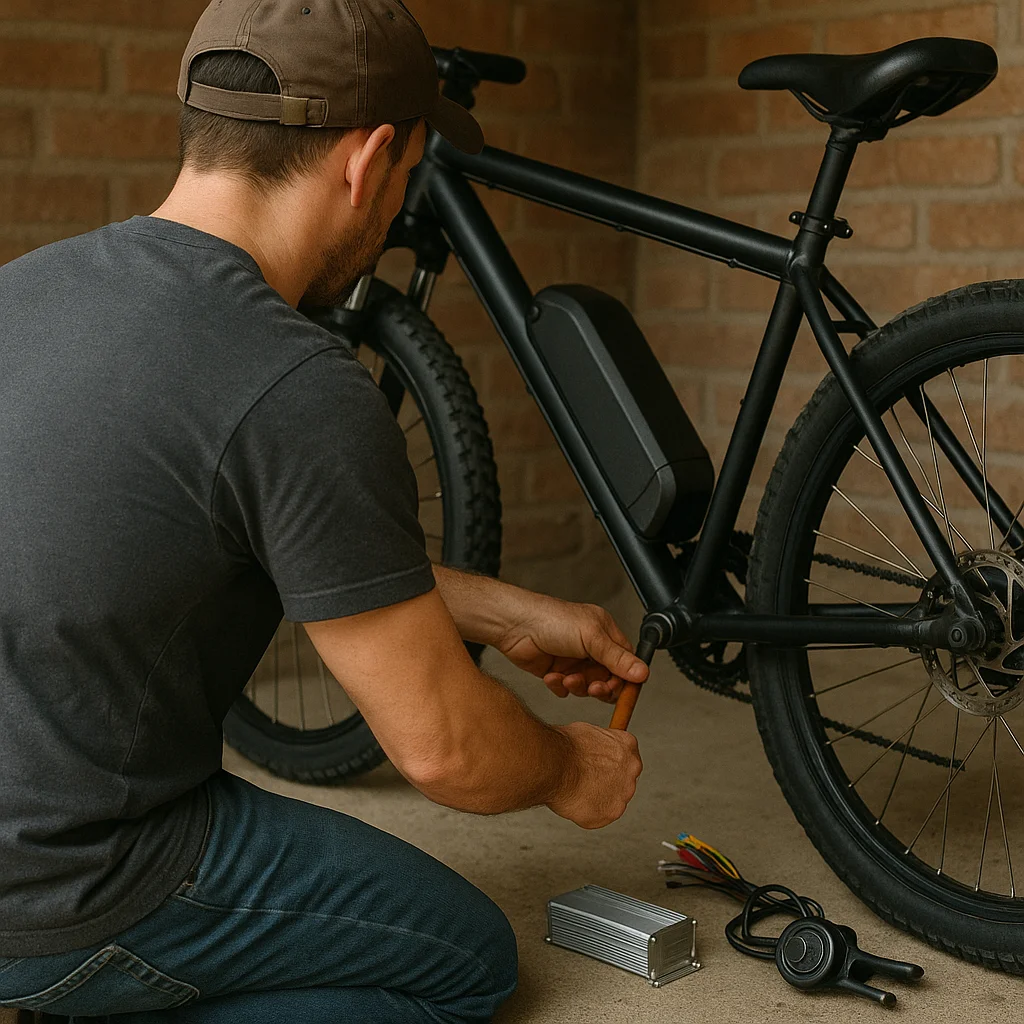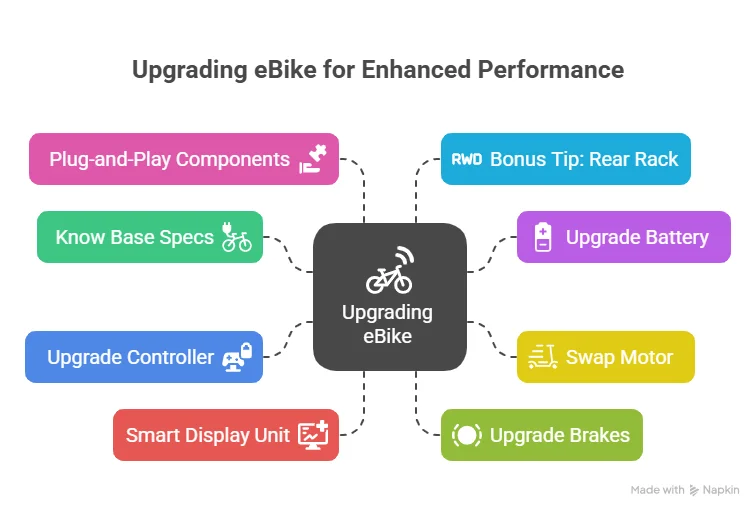Ebike Upgrade: Easy tips to Make Your Electric Bike Go Faster

Want to make your eBike go faster without voiding the warranty or breaking the bank? Whether you’re cruising at 18mph or aiming for 28mph, there are smart ways to unlock more speed and performance from your electric bike. In this guide, you’ll learn how to boost speed safely, legally, and effectively using beginner-friendly upgrades and tweaks.
Understanding Your eBike’s Basics
Before diving into upgrades, it’s important to understand the foundation of your eBike.
Most entry-level eBikes, like mine, come with a 36V battery and a 250–350W motor. They’re perfect for commuting but cap out around 25–32km/h. I wanted more speed, more power, and better handling. So, I set out to transform it step-by-step without spending a fortune on a new bike.
Cost Breakdown of Each Upgrade
Here’s what I upgraded, why, and how much it all cost me:
| Upgrade | Why I Upgraded | Cost (USD approx.) for eBike upgrades can vary significantly. |
|---|---|---|
| 48V Battery (20Ah) | More volts = more top speed and torque | ~$145 for advanced components that enhance speed and power. |
| 1000W Hub Motor (Rear) | Replaced 250W motor for serious power gains | ~$110 |
| 48V 35A Controller | To handle increased power output | ~$22 for basic upgrades that can make your eBike faster. |
| Better Display Unit | Needed one to monitor speed, voltage, range etc. | ~$12 |
| Upgraded Brake System is crucial for safety as your bike accelerates at higher speeds. | Safety first when doubling your speed | ~$30 |
| Throttle with PAS | Smooth riding and better motor control | ~$6 |
| Rear Rack for Battery | Mounted heavy battery securely | ~$4 |
Total Cost: (~$330 USD)
All upgrades were plug-and-play. No welding or programming needed!
Realistic Speed Gains You Can Expect
Let’s talk numbers. After the upgrades:
- Before: Top speed was 32km/h, range ~45km.
- After: Top speed is 60km/h+, range ~70km (with pedaling assist).
The real surprise? The acceleration. Climbing hills no longer feels like a workout, and cruising at 50km/h feels effortless.
Important: You won’t instantly hit 60km/h unless your terrain is smooth, wind is favorable, and your tires are properly inflated. But even in mixed conditions, 45–55km/h is easy to maintain.

how to upgrade any ebike to go super fast
1. Keep Your Battery Fully Charged
A fully charged battery ensures consistent motor power, which is essential for achieving a higher top speed. When your battery gets low or begins to degrade, your e-bike’s performance will dip, especially when accelerating or climbing.
Make it a habit to charge your battery to 100% before each ride. If your e-bike feels slower than usual, check battery health or consider upgrading to a higher voltage or larger capacity model.
2. Crank Up the Pedal Assist Level
Most e-bikes have multiple pedal-assist levels (often ranging from 1 to 5). Increasing the level boosts how much power your motor contributes when you pedal. It’s one of the simplest ways to make your eBike faster without modifying your hardware.
Keep in mind that higher assist levels consume more battery, so use them strategically based on your route.
3. Unlock Built-In Speed Limits (If Legal)
Many e-bikes come with a built-in speed limiter to comply with local laws. For example, some models are capped at 15.5 or 18mph but allow riders to configure settings up to 25 or 28mph, increasing their speed and power.
Check your e-bike’s manual or controller menu for a “top speed setting” or “advanced mode.” Adjusting this could unlock a faster e-bike experience—just ensure it aligns with legal limits in your region.
4. Upgrade to a Higher Voltage Battery
Switching from a 36V to a 48V battery can significantly increase your e-bike’s torque, acceleration, and top speed. More voltage means more available power, allowing the motor to spin faster and pull harder under load.
This is a popular upgrade among those looking to make their eBike go faster—but ensure your motor and controller are built to handle the extra voltage. Otherwise, you risk damage or voiding your warranty.
5. Fine-Tune Your E-Bike’s Controller
Your e-bike’s controller manages how much power goes from the battery to the motor. Adjusting this can improve acceleration, throttle sensitivity, and your e-bike’s maximum speed.
Many modern controllers let you configure speed sensors for better performance.
- Speed limit settings
- Pedal-assist responsiveness can be adjusted to make your eBike faster.
- Acceleration curve
You may also consider a complete controller upgrade to unlock more power and control—just verify compatibility with your existing motor and battery setup.
6. Swap to Slimmer, Low-Resistance Tires
Tires make a bigger difference than most riders realize. Fat tires offer grip and comfort but create more rolling resistance. Slimmer road-style tires reduce drag, allowing you to go faster with less effort.
Swapping from 4-inch fat tires to 2-inch slick tires can noticeably improve speed, especially on paved roads. Be sure the new tires fit your rim size and riding style.
7. Consider Larger Wheel Size
Bigger wheels cover more ground per rotation, which can help your e-bike go faster with the same amount of pedaling. If your current setup uses 20” wheels, upgrading to 26” or 29” wheels may improve speed and smoothness.
Always confirm your frame and fork can handle the new wheel size to avoid mechanical issues.
8. Inflate Tires to the Proper Pressure
Low tire pressure increases surface contact and slows your bike down. Keeping your tires inflated closer to the upper PSI limit reduces rolling resistance and helps your e-bike maintain higher speeds.
Check the PSI rating printed on your tire sidewall and inflate accordingly—usually between 30 and 50 PSI for most e-bikes. Avoid overinflating, which can lead to blowouts or poor handling.
9. Lighten the Load
Reducing unnecessary weight improves acceleration and efficiency. Start by removing non-essential accessories like racks, saddlebags, baskets, or heavy locks.
If you’re planning a rebuild, consider a lightweight frame material (like aluminum) and components that cut down on rotational mass—like lighter wheels or cranksets. A lighter e-bike accelerates faster and feels more responsive.
10. Upgrade Your Gear Setup
Your e-bike’s drivetrain plays a critical role in how effectively you transfer pedaling power to the ground. A higher gear ratio means each pedal stroke pushes your bike farther.
Upgrades to consider:
- A larger front chainring (e.g., from 42T to 50T) can contribute to a higher top speed.
- A smaller rear cassette or cog
- A smoother-shifting derailleur setup can help enhance speed and power.
These changes can help you maintain higher speeds with less strain. However, gear upgrades should be done with care to avoid stressing the motor or causing compatibility issues.
What About 250W Motors?
Many entry-level electric bikes use 250W hub motors, often paired with 36V batteries. These setups are reliable for commuting and light riding but aren’t designed for high-speed use.
While you can boost performance slightly, expecting a 250W system to reach or maintain 28mph consistently is unrealistic. For those speeds, you’ll likely need a 750W or 1000W motor with higher peak power and amperage.
Understanding Legal Limits
Before tweaking any settings or doing a controller upgrade, make sure you understand how your local laws classify e-bikes.
- Class 1: Pedal-assist only, limited to 20 mph
- Class 2: Throttle-assisted, also limited to 20 mph
- Class 3: Pedal-assist only, up to 28 mph (helmet and restrictions may apply)
Modifying your e-bike to exceed these limits may reclassify it as a moped or motor vehicle, requiring insurance, registration, or even a license.
Quick FAQs
How can I make my e-bike go faster without replacing parts?
You can increase pedal assist, inflate your tires properly, and unlock your speed limiter (if available and legal).
Will a higher voltage battery make my e-bike faster?
Yes, a higher voltage battery provides more power, but only if your motor and controller are built to handle it.
What’s the best speed upgrade for a 250W e-bike?
Adjust your top speed settings, optimize your gearing, and use lighter tires. For major speed gains, consider a motor upgrade.
Is it safe to disable my e-bike’s speed limiter?
Only if you understand the risks, have proper safety gear, and the change complies with local regulations.
Can eBikes be modified to go faster?
Yes! You can upgrade the motor, battery, or controller—or tweak settings—to boost speed. Just check local laws first.
How to get more speed out of an eBike?
Upgrade to a higher-voltage battery (like 48V), install a more powerful motor, reduce weight, and keep tires fully inflated.
How do I remove the speed limiter on an electric bike?
Some eBikes let you adjust or disable the limiter via the display settings. Others may need rewiring or a custom controller. Note: This may void warranties and be illegal in some areas.
How do I unrestrict an eBike to make it go faster?
Use the display menu or controller settings to change the speed limit—if supported. For advanced users, swapping the controller or firmware helps. Ride responsibly on your fast eBike!
36V vs. 48V eBike Batteries: Which One Is Right for You?
Go with 36V for basic commuting and lighter rides. Choose the right upgrades to make your eBike faster. 48V for faster speeds, steeper climbs, and more power-hungry setups.
What’s the fastest legal eBike setup?
In many places, the legal limit is 25–32km/h (15–20mph) with a 750W motor max. For max legal speed, pair a 48V battery with a 750W motor and pedal-assist.
Final Thoughts
Absolutely. I spent just over (~$330) and ended up with a custom eBike that rivals some $1,000+) models. If you enjoy tinkering, want to save money, and crave speed, this DIY route is unbeatable.
If you’re looking to make your e-bike go faster, start with simple, cost-effective upgrades like adjusting your pedal-assist settings, tire pressure, and controller options. If you’re serious about speed, you can dive into bigger upgrades—like increasing battery voltage, switching out your tires, or improving your drivetrain.
Just remember: faster e-bikes need better handling and braking, so always prioritize safety. And before unlocking built-in speed settings or replacing components, make sure your upgrades are legal and compatible with your bike.
Ride safe, and enjoy the wind in your face with every mile per hour gained.

Leave a Reply